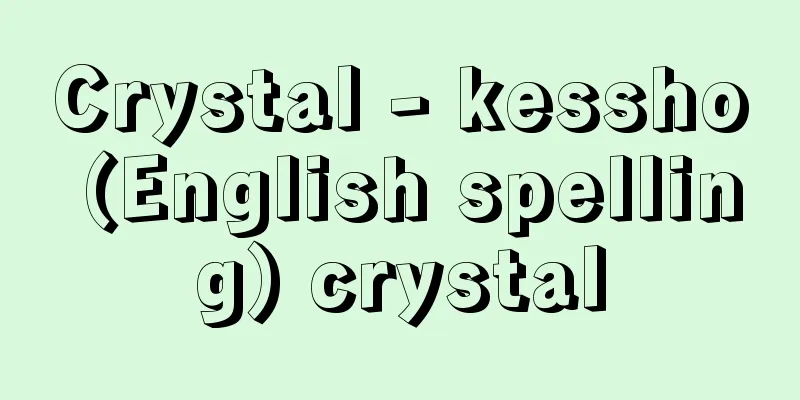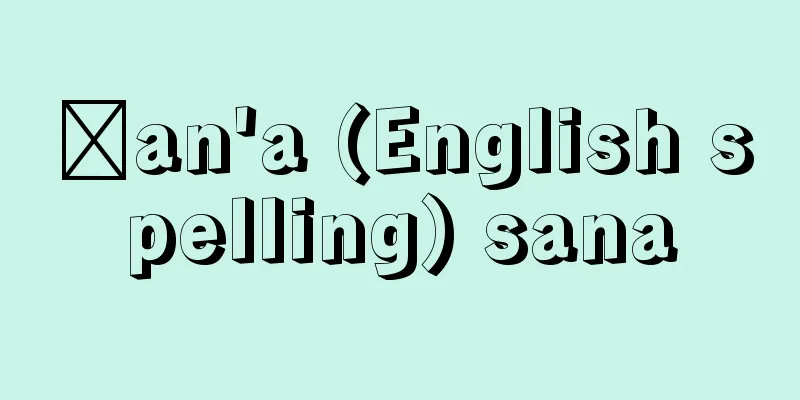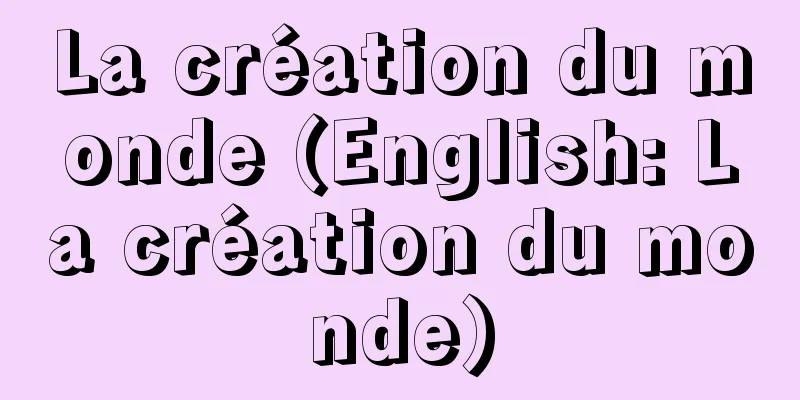Crystal - kessho (English spelling) crystal

|
A state in which a substance exists in a solid. Externally, it appears as a polyhedron with smooth polygonal faces joined by sharp edges. Microscopically, it is characterized by a three-dimensional periodic arrangement of the atoms, molecules, ions, etc. that make up the substance. The regularity of the three-dimensional arrangement is expressed geometrically by a spatial lattice (crystal lattice) and its symmetry, and due to this regularity, physical properties such as optical properties, mechanical properties, electrical properties, and magnetic properties differ depending on the direction within the crystal, meaning that it exhibits anisotropy, which is also a characteristic of crystals. Materials such as glass do not have these crystalline characteristics and are called amorphous and are distinguished from crystals. Even if the powder does not show any crystal-like external characteristics to the naked eye, they may be visible under a microscope. A single crystal is called a single crystal when it shows the same axial properties as the crystal lattice. In real crystals, single crystals of various orientations may aggregate to form a single crystal, which is called a polycrystal. Even in single crystals, such structural disorders are thought to exist on a small scale. Even amorphous materials such as polymers and glass often have a crystalline structure in parts, and it is thought that a crystalline state is more stable as a solid. In old glass, partial crystallization may progress, causing devitrification in those parts, losing the viscosity characteristic of glass and making it brittle. Even in the case of a liquid, if the constituent molecules are rod-like or plate-like in shape, the molecules can align regularly and exhibit anisotropic properties like those of a crystal; such a liquid is called a liquid crystal. [Shinmyo Iwamoto, August 19, 2015] Packing the spheresThe reason why a substance that is liquid or gas at high temperatures crystallizes when the temperature is lowered is because the kinetic energy of the constituent particles of the substance decreases as the temperature is lowered, and the effect of the attractive forces between the particles becomes greater. Therefore, during crystallization, the constituent particles such as atoms, molecules, and ions aggregate in such a way that the voids are as small as possible. The simplest of these particles is an atom, and the crystals of noble gases and metal elements can be thought of as agglomerations of hard spheres of the same size. If hard spheres are arranged on a flat surface with as little space as possible, each sphere will be surrounded by six other spheres. [Shinmyo Iwamoto, August 19, 2015] Close-packed structureIf these layers of spheres are stacked one after the other, a three-dimensional close-packed structure is obtained. Let us now call the center of the sphere in the first layer a, and call the arrangement layer A. In layer A, two types of voids, b and c, are generated between the three spheres. Since both are equivalent, the second layer is stacked so that the center of the sphere is above the void b. Then, there are two ways to stack the next layer. One is to place the same arrangement A as the first layer, and the other is to place the third layer on the void c of the first layer. The former structure stacked by repeating AB is called a hexagonal close-packed structure, and if the center of each sphere in arrangement A is taken as a lattice point, a simple hexagonal lattice is obtained. The latter structure, which repeats ABC, results in a cubic close-packed structure, and if the center of each sphere is taken as a lattice point, a face-centered cubic lattice is obtained. In either case, the volume occupied by the spheres in the unit lattice (unit cell) (packing ratio) is 74% of the volume of the unit lattice. The body-centered cubic structure, which has a slightly larger void volume than the close-packed structure, is also commonly seen in single crystals, and the packing rate of this structure is 68%. In both cubic close-packed and hexagonal close-packed structures, one sphere is adjacent to 12 spheres. In a body-centered cubic structure, the number is 8, but if the spheres at the body centers of the six adjacent unit cells are included, the number becomes 14. In this way, when focusing on a certain atom in a crystal, the number of atoms adjacent to that atom is called the coordination number of that atom. Two types of voids occur between the spheres packed in a close-packed structure. One type is surrounded by four spheres, and its center is the center of a regular tetrahedron obtained by connecting the centers of the spheres. The other type is surrounded by six spheres, and its center is the center of a regular octahedron obtained by connecting the centers of the spheres. In the body-centered cubic structure, there are also voids surrounded by four and six spheres, respectively, but these structures are much more distorted than the regular tetrahedron and regular octahedron. When other atoms or ions fill these voids, they form compound crystals, and since compounds have a variety of combinations of shapes and dimensions of atoms, molecules, and ions, the crystal structures become correspondingly more complex. [Shinmyo Iwamoto, August 19, 2015] Spatial latticeIf a substance has a certain crystal structure, its single crystal will have characteristics that reflect that structure. Crystals of the same substance may also show different shapes depending on the conditions of the medium in which they are grown. For example, sodium chloride crystals grown from a pure aqueous solution will be cubic, but those grown from a 10% urea solution will often be regular octahedrons. Such characteristics of the shape are called crystal habits, and both reflect the arrangement of atoms within the crystal. Sodium chloride has a face-centered cubic lattice structure, and it is easy to see that it shows the shape of a cube. It can also be seen from a simple diagram that if you connect the positions of the face centers of this cube, it will become a regular octahedron. The periodicity of a crystal structure is expressed by a spatial lattice, but if we first consider one-dimensional periodicity, an example of identical figures lined up on the a- axis is easy to understand. If we take any one point (lattice point) in the figure and connect it to the lattice points in the neighboring figures of the same value, we will create an array of points spaced a apart on the a- axis. The value of a does not change no matter where the point is set on the figure. This array of points is called a one-dimensional lattice, and a is its fundamental period. Next, if we line up one-dimensional lattices in parallel at equal intervals, we create a two-dimensional lattice. A two-dimensional lattice is defined by the fundamental period a of the a- axis, the fundamental period b of the b- axis, and the angle γ made by the a and a -axes. In this case, the value of b should be set as small as possible. If we stack two-dimensional lattices in parallel at equal intervals, we create a three-dimensional lattice. This is a spatial lattice (crystal lattice). A space lattice is created by translating a parallelepiped, whose three sides are a , b , and c and the angles between them are α , β , and γ , along each axis. This parallelepiped is the unit lattice (unit cell). In this case, it is common to set a , b , and c to be as short as possible, and α , β , and γ to be 90 degrees or as close to 90 degrees as possible. If a plane (lattice plane) is created by arbitrarily selecting lattice points of a spatial lattice, a combination of planes that are equally spaced and parallel to it will be obtained. These lattice planes will ultimately include all the lattice points. A lattice plane always intersects the a , b , and c axes at intervals of a / h , b / k , and c / l, respectively. h , k , and l are integers including 0, and are called the Miller indices of the lattice plane. When the Miller indices are 0, the axis is intersected at infinity, that is, the plane is parallel to that axis. Lattice planes are represented by the Miller indices with the symbol ( hkl ), and negative indices are represented as (). Taking sodium chloride as an example, a cubic crystal grown from a pure aqueous solution has [Shinmyo Iwamoto, August 19, 2015] Symmetry and point groups (crystal families)If an object with a certain shape is rotated around an axis that passes through it and it matches (is aligned with) the original shape, then that axis is called the axis of rotation. All objects are aligned when rotated 360 degrees. Elements of symmetry, such as axes, mirror surfaces, and centers of symmetry, that determine the symmetry of an object are called symmetry operations, while operations based on elements of symmetry such as rotation, reflection, and inversion are called symmetry operations. An n -fold rotation axis is an axis of rotation that is aligned with a rotation of (360/ n ) degrees. An operation that combines rotation and inversion is called inversion, and when an object is rotated around an axis of rotation and then inverted about a point on that axis, and the object is aligned with the original shape, then that axis is called an inversion axis. A one-fold inversion axis is nothing but the existence of a center of symmetry, and a two-fold inversion axis is nothing but the existence of a mirror surface perpendicular to that axis. Inversion is the operation of moving a point with coordinates ( x , y , z ) to coordinates ( -x , -y , -z ) with the center of symmetry as the origin, and reflection is the operation of moving a point in front of a plane (mirror surface) to the opposite side by an equal distance on a line perpendicular to the mirror surface. Looking at the characteristics that appear in the external shape of a crystal from the perspective of symmetry, it is known that there are only eight types of symmetry elements that are allowed to exist independently in a crystal: 1-, 2-, 3-, 4-, and 6-fold rotation axes and 1-, 2-, and 4-fold inversion axes.
These and thirty-two other suitable combinations of symmetries can occur in crystals; these are called point groups or crystal families. The term group is used because they satisfy the mathematical group axioms. Point groups are represented by the Schönfries or Hermann-Morgan symbols, the latter being more convenient since they show the symmetry elements of the crystal. [Shinmyo Iwamoto, August 19, 2015] Crystal SystemThere is some arbitrariness in how the unit cell is selected, but if a , b , and c are set as short as possible, and α , β , and γ are set to 90 degrees or as close to 90 degrees as possible, the unit cells can be classified into seven types according to their shape characteristics. These are called crystal systems. The spatial lattice of a crystal is created by the parallel translation of the unit cell, so as mentioned earlier, the rotation axis allowed for the crystal is limited. If we consider a two-dimensional plane for simplicity, it is impossible to fill the plane with the same shape without any gaps using a regular pentagon or regular octagon, but it is possible with equilateral triangles, parallelograms, regular hexagons, etc. [Shinmyo Iwamoto, August 19, 2015] Bravais latticeAll lattice points in a space lattice are equivalent. When a unit lattice is taken and a crystal axis is set with one of its vertices as the origin, the lattice points at the remaining seven vertices have exactly the same geometric relationship as the origin. Such lattice points can exist in addition to the eight vertices of a unit lattice. When such a lattice point also exists at the center of a pair of parallel faces of a parallelepiped within the unit lattice, it is a base-centered lattice, and when it also exists at the center of all three pairs of parallel faces, it is a face-centered lattice. When it exists at the center of a parallelepiped, it is a body-centered lattice. In contrast, a lattice made up of only eight lattice points is called a simple lattice. The possible lattices for the seven crystal systems were clarified by the Frenchman Bravais in 1850, and it is known that only 14 types are possible. These are called the Bravais lattice. In the trigonal crystal system, there is one that corresponds to the simple rhombohedral lattice and one that corresponds to the simple hexagonal lattice. In contrast to the simple lattice, other lattices are called multilattices, body-centered and base-centered lattices are called double lattices (multiplicity 2) or double lattices, and face-centered lattices are called quadruple lattices (multiplicity 4). The base-centered lattice is sometimes called the side-centered lattice. For all lattices, each vertex of the parallelepiped is equivalent. [Shinmyo Iwamoto, August 19, 2015] Space groupThe symmetry of the Bravais lattice is only the symmetry of the shape itself, and does not indicate how the atoms are arranged in the unit cell. Point groups and Bravais lattices are isolated structures that are extracted from periodic crystal structures, but there are unit cells next to each other in the crystal. If we consider parallel translation to the neighboring unit cells, new symmetry elements arise. These are the helical axis and the glide plane. The helical axis is a combination of rotation and translation along that axis. The glide plane is a combination of reflection on a mirror surface and translation along the mirror surface, and the translation distance is half of each period, half the sum of any two periods (diagonal glide planes), or a quarter of the sum or difference of any two periods, or a quarter of the sum or difference of three periods (diamond glide planes). In addition, the symmetric operation of rotation + reflection is called a reflection, and the 1-time rotation axis is equal to the 2-time reflection axis, and the 2-time reflection axis is equal to the 1-time reflection axis. The number of combinations allowed in the crystal structures of crystal systems, point groups, Bravais lattices, helical axes, and glide planes is limited to 230 types, and each of these has the mathematical properties of a group, so they are called space groups. The symmetry elements of space groups are described in detail in International Tables for Crystallography, Vol. A, published by the International Union of Crystallography. Space groups are numbered in the order in which they are listed in the book, and both Schönfries symbols and Hermann-Morgan symbols are listed. The Schönfries symbols are simply numbers in the order in which they are listed to the right of the corresponding point group symbols, and the explanation of the symmetry elements is somewhat insufficient. The Hermann-Morgan symbols are a convenient way to understand the contents of a space group, as they consist of the Bravais lattice symbol, followed by the minimum necessary symmetry elements. The Hermann-Morgan symbols are commonly used to describe crystal data. [Shinmyo Iwamoto, August 19, 2015] Crystal TypeCrystals can be classified according to whether the chemical species that make up the crystal are atoms, ions, or molecules, or based on the type of chemical bonds that form the crystal. [Shinmyo Iwamoto, August 19, 2015] Metal CrystalSimple metals and alloys often have crystal structures in which atoms form face-centered cubic (cubic close-packed), hexagonal close-packed, or body-centered cubic structures. The bonding electrons (valence electrons) provided by each atom form metallic bonds shared throughout the metal crystal. The crystal structure generally depends on the number of electrons used in metallic bonds per atom; when the number is 1.5 or less, it is a body-centered cubic structure, when it is 1.7 to 2.1, it is a hexagonal close-packed structure, and when it is 2.5 to 3.2, it is a face-centered cubic (cubic close-packed) structure. In metal crystals, it is often thought that there is no directional bond between each atom, and it can be considered that there is a sea of metallic bonding electrons throughout the metal crystal, with metal atoms (cations) arranged like islands within it. Therefore, when an external force is applied, the layers of atoms (cations) move easily, and the crystal exhibits ductility (the ability to stretch into a long, thin shape) and malleability (the ability to spread out thinly). [Shinmyo Iwamoto, August 19, 2015] Covalent CrystalDiamond is a typical example of a crystal that is composed of atoms connected by directional covalent bonds. In diamond, each carbon atom occupies a position that doubles as both the vertex and the center of a regular tetrahedron, and each atom is bonded to four atoms, forming a three-dimensional infinite continuous structure. In other words, a single crystal itself is considered to be composed of a giant molecule, and these are called giant molecules. Elements of group 14 elements such as silicon and germanium also have a diamond-type structure. Compounds of group 13 and group 15 elements, which have an average of four bond electrons per atom, and compounds of group 12 and group 16 elements, can also form structures similar to diamond. Covalent crystals are generally very hard, and boron nitride, which has the same structure as diamond, is harder than diamond. They also have extremely high melting points. However, because of the strict directionality of the bonds, they lack ductility and malleability, and are fragile against external forces that can break them. Elemental Group 14 elements such as silicon and germanium, and compounds of Group 13 and Group 15 elements (GaP, GaAs, etc.) are used as semiconductors in electronic materials. [Shinmyo Iwamoto, August 19, 2015] allotropeEven if they are simple substances of the same element, those with different molecular or crystal structures are called allotropes. Graphite is an allotrope of carbon, just like diamond, but the covalent bonds between carbon atoms form a two-dimensional layered structure. Each atom bonds with three other atoms to form a regular hexagonal mesh surface, creating a two-dimensional continuous structure. However, there are no direct chemical bonds between the layers, and only intermolecular forces act, similar to molecular crystals. Therefore, it can be considered a molecular crystal, as described below. In addition to the diamond type, there are also boron nitrides that have a graphite type structure, and because the intermolecular forces between layers are much weaker than the covalent bonds within the layers, they exhibit cleavage, which allows the layers to peel off, and lubricity due to sliding between layers. [Shinmyo Iwamoto, August 19, 2015] Molecular CrystalThe simplest molecules are monoatomic molecules such as those found in the noble gases, which mainly form crystals with a face-centered cubic structure. This type of crystal is cohesive due to intermolecular forces, but has the characteristic of having an extremely narrow temperature range in which it remains liquid. In polyatomic molecular crystals, those with larger molecular weights generally have higher melting points, but the shape and polarity of the molecules also have a large effect. In polar substances, electrostatic interactions due to electric dipole moments and hydrogen bonds also contribute to the cohesive force of the crystals. [Shinmyo Iwamoto, August 19, 2015] Ionic CrystalsIonic crystals are formed by ionic bonds. They have relatively high melting points and exist as liquids over a wide temperature range. Some substances that appear to be ionic crystals have a high degree of covalent bonding, and they may exhibit properties similar to those of covalent crystals with one-, two-, or three-dimensional continuous structures. [Shinmyo Iwamoto, August 19, 2015] Crystal growthCrystals of substances that form a solution with a suitable solvent grow from that supersaturated solution. A supersaturated solution can be obtained by cooling a high-temperature saturated solution using the temperature difference of solubility, or by evaporating the solvent at room temperature. In these cases, it is possible to obtain large single crystals by slowing down the cooling or evaporation rate, but if the rate is high, small microcrystals are often obtained. Impurities or mother liquor may also be incorporated during crystal growth. In such cases, the crystals are removed and put into solution again to attempt recrystallization. Sublimation is the direct transformation of a solid into a gas, but the opposite is also true when a gas becomes a solid. When the gas obtained by sublimating a solid is collected in a cool place and crystallized, it can become a good single crystal. For inorganic compounds and metal salts, crystal growth from a melt or molten salt solution has been put to practical use as a single crystal production method. In the single crystal pulling method, the material to be crystallized is melted at a temperature slightly higher than the melting point, and a seed microcrystal is immersed in the melt in a vacuum or inert gas atmosphere and gradually cooled while being pulled up to grow the crystal. There are various other methods, and this method is often applied to the production of electronic materials that require high purity. Crystals that have developed into dendritic shapes like those seen in snowflakes are often obtained by evaporating a solvent from a saturated solution, and are made up of fine single crystals connected together, but each single crystal is said to have a good structure with a regular axis. [Shinmyo Iwamoto, August 19, 2015] Crystal propertiesThe properties of a crystal are derived from the atoms or molecules that compose it, and often also from their relative positions within the crystal. The resulting anisotropy is seen in optical properties such as the refractive index, optical absorption coefficient, optical rotation, and depolarization. Electrical properties include electrical conductivity and dielectric constant, magnetic properties include magnetic susceptibility, and mechanical properties include compressibility and elasticity, as well as cleavage along a certain crystal plane. Thermal properties such as the change in specific heat with temperature are also related to the rearrangement and mobility of molecules within the crystal. The relationship between the structure of a crystal and these various properties provides important information for understanding the nature of matter and chemical bonding. [Shinmyo Iwamoto, August 19, 2015] Artificial gemstonesAlchemy was rejected by the development of modern chemistry, but the artificial production of expensive gemstones such as diamonds developed with the advancement of high-temperature and high-pressure technology. When it was discovered that diamonds are composed of nothing more than carbon, many chemists tried to synthesize them artificially. The first attempts were made by France's Moissan and an unknown British chemist named Hannay at the end of the 19th century, and in the 20th century, Harvard University physicist Bridgman and others conducted synthesis experiments under ultra-high pressure, which brought about significant advances in ultra-high pressure physics, but all attempts were unsuccessful in the scientific sense of diamond synthesis. In 1956, General Electric of the United States succeeded in synthesizing diamonds under conditions of 95,000 atmospheres and 1,600 degrees Celsius. On the other hand, the artificial synthesis of corundum-based gemstones such as rubies and sapphires developed relatively quickly, and they are widely used in bearings, record needles, decorations, etc. Many gemstones are crystals that have grown naturally under special conditions of high temperature and high pressure associated with the evolution of the earth, and in principle they can be synthesized if such conditions can be artificially set. [Shinmyo Iwamoto, August 19, 2015] "X-Ray Crystallography, Volumes 1 and 2, edited by Isamu Nitta (1961, Maruzen)" ▽ "Chemical Crystallography, written by C.W. Bunn, translated by Yoshio Sasada (1970, Baifukan)" ▽ "Introduction to Chemical Crystallography, written by Yoshihiko Saito (1975, Kyoritsu Shuppan)" [Reference items] | | | | | | | | | | Tetragonal system | | | | Equiaxed | | | | | |©Shogakukan "> Differences between crystal, glass, and liquid crystal ©Shogakukan "> Close-packed structure ©Shogakukan "> Crystal structure of sodium chloride ©Shogakukan "> Periodicity of crystal structure and unit cell ©Shogakukan "> Division of spatial lattice by lattice planes ©Shogakukan "> Explanation of symmetric elements using plane figures ©Shogakukan "> Crystal system and crystal family ©Shogakukan "> 14 types of Bravais lattice ©Shogakukan "> Comparison of symmetry elements of space groups ©Shogakukan "> Crystal structures of various metals at room temperature ©Shogakukan "> Characteristics of each crystal and representative minerals Source: Shogakukan Encyclopedia Nipponica About Encyclopedia Nipponica Information | Legend |
|
物質の固体における存在状態の一つ。外見上は、平滑な多角形の面が鋭い稜(りょう)によって組み合わされた多面体となる。微視的には、その物質を構成する原子、分子、イオンなどが三次元的に周期性のある配列をとることが特徴である。三次元的配列の規則性は空間格子(結晶格子)とその対称性によって幾何学的に表現され、その規則性のために光学的性質、機械的性質、電気的性質、磁気的性質などの物理的性質が結晶内の方向によって異なる、つまり異方性を示すことも結晶の特徴である。ガラスのような物質にはこのような結晶としての特徴はなく、非晶質とよばれて結晶とは区別される。 肉眼では結晶としての外見上の特徴が観察されない粉末であっても、顕微鏡ではそれが観察されることもある。1個の結晶が結晶格子と同じ軸方向の性質を示すものを単結晶single crystalという。実際の結晶では、さまざまな配向の単結晶が凝集して1個の結晶になっているものがあり、これを多結晶polycrystalという。単結晶であっても、このような構造の乱れは小規模に存在していると考えられている。高分子やガラスのような非晶質でも、部分的には結晶構造をもつことが多く、固体の存在状態としては結晶になるほうが安定であると考えられている。古いガラスでは部分的に結晶化が進行してその部分が失透し、ガラス特有の粘性が失われて、もろくなることがある。 液体であっても、その構成分子の形が棒状や板状であると、それらの分子が規則的に配向して、結晶のような諸性質の異方性を示すことがあり、そのような液体を液晶という。 [岩本振武 2015年8月19日] 球体の充填高温度では液体や気体になっている物質が温度の低下によって結晶化するのは、その物質の構成粒子の運動エネルギーが温度の低下によって小さくなり、粒子間の引力の効果のほうが大きくなるからである。したがって、結晶化の際には、原子、分子、イオンなどの構成粒子は、なるべく空隙(くうげき)を小さくするように凝集する。 これらの粒子のもっとも簡単なものは原子であり、貴ガス(希ガス)や金属元素の単体の結晶は同寸法の剛体球が凝集したものと考えることができる。平面上に剛体球をなるべく空隙が小さくなるように並べると、1個の球がそれぞれ6個の球に囲まれる配列となる。 [岩本振武 2015年8月19日] 最密構造この球の層を順次積み上げると三次元の最密構造が得られる。いま第1層の球の中心をaとし、その配列をA層とする。A層には、3個の球の間の空隙としてbおよびcの2種類が生ずる。そのどちらも同価であるから、第2層は球の中心がbの空隙の上にくるように積み上げたとする。すると、次の層を積み上げるやり方は二通りある。一つは第1層と同じ配列Aをのせるやり方であり、もう一つは第1層の空隙cの上に第3層をのせるやり方である。前者のABの繰り返しで積み上げた構造を六方最密構造といい、配列Aの各球の中心を格子点とすると単純六方格子ができる。ABCを繰り返す後者で生ずるのは立方最密構造であり、各球の中心を格子点とすると面心立方格子を得る。いずれの場合も、単位格子(単位胞)の中で球が占める体積(充填(じゅうてん)率)は単位格子の体積の74%である。最密構造よりやや空隙の体積が大きくなる体心立方構造も単体の結晶にはよくみられるが、この構造での充填率は68%になる。 立方最密構造、六方最密構造のいずれにおいても、1個の球には12個の球が隣接する。体心立方構造ではその個数は8となるが、隣接する6個の単位格子の体心にあるやや離れた球まで含めれば14となる。このように、結晶中のある原子に着目し、その原子に隣接して位置する原子の個数を、その原子の配位数という。 最密構造で詰め込まれた球の間には2種類の空隙を生ずる。一つは4個の球に囲まれた空隙で、その中心は各球の中心を結んで得られる正四面体の中心になっている。別の空隙は6個の球に囲まれ、その中心は各球の中心を結んで得られる正八面体の中心になっている。体心立方構造においても、それぞれ4個および6個の球に囲まれた空隙があるが、正四面体および正八面体よりかなりひずんだ構造となる。これらの空隙にほかの原子やイオンが入り込むと化合物の結晶になるが、化合物では原子、分子、イオンの形や寸法の組合せがさまざまに変わるから、それに応じて結晶の構造も複雑になる。 [岩本振武 2015年8月19日] 空間格子ある物質が一定の結晶構造をもつならば、その単結晶には構造を反映した特徴が現れる。同一物質の結晶が、成長した媒質の条件によって異なる外形を示すこともある。たとえば、純水溶液から成長した塩化ナトリウムの結晶は立方体となるが、10%尿素水溶液から成長したものは正八面体となることが多い。このような外形の特徴を晶癖(しょうへき)というが、いずれも結晶内の原子の配列状態を反映したものである。塩化ナトリウムでは、面心立方格子の構造をもっており、立方体の外形を示すことは容易に理解できよう。またこの立方体の面心の位置を結ぶと正八面体になることも簡単な作図から理解できる。 結晶構造の周期性は空間格子によって表されるが、まず一次元の周期性から考えてみると、a軸上に同一図形が並んでいる例がわかりやすい。図形内に任意の1点(格子点)をとり、それと同価の隣の図形内の格子点と順次結んでいくと、a軸上に距離aの間隔を置いた点の配列ができる。図形のどこに点を設定してもaの値に変わりはない。この点の配列を一次元格子、aをその基本周期という。次に一次元格子を等間隔で平行に並べると二次元格子ができる。二次元格子は、a軸の基本周期a、b軸の基本周期b、およびab両軸のつくる角γで規定される。このときbの値はなるべく小さくなるよう設定する。二次元格子を等間隔で平行に積み上げれば三次元格子ができる。これが空間格子(結晶格子)である。空間格子は、3辺の長さがa、b、c、それらの間でつくる角α、β、γで規定される平行六面体を一単位とし、これを各軸に沿って平行移動させればつくられる。この平行六面体が単位格子(単位胞)である。このとき、a、b、cはなるべく短く、α、β、γは90度あるいはなるべく90度に近い値となるよう設定するのが普通である。 空間格子の格子点を任意に選んで平面(格子面)をつくると、それと等間隔で平行な平面の組合せが得られる。それらの格子面は、結局すべての格子点を含むことになる。格子面はa、b、c軸をそれぞれかならずa/h,b/k,c/lの間隔でくぎっている。h、k、lは0を含む整数で、格子面のミラー指数Miller indicesとよばれる。ミラー指数が0となるときは、その軸を無限遠でくぎる、つまりその軸に対して平行な面である。格子面はミラー指数によって(hkl)の記号で示され、負の指数となる場合は()のようにして示す。塩化ナトリウムを例にとると、純水溶液から成長した立方体の結晶には [岩本振武 2015年8月19日] 対称と点群(晶族)ある形をもつ物体をその物体を貫通する適当な軸の周りに回転させ、元の形と一致する(同位する)ことがあれば、その軸を回転軸という。すべての物体は360度回転させれば同位する。軸、鏡面、対称心などのように、それに基づいて物体の対称性を決めるものを対称要素、回転や鏡映、反転などの対称要素に基づいて行う操作を対称操作という。n回回転軸とは、(360/n)度の回転で同位する回転軸である。回転と反転とをあわせて行う操作を回反というが、ある物体を回転軸の周りで回転させ、ついでその軸上にある点について反転させれば同位するとき、その軸を回反軸という。1回回反軸は対称心の存在にほかならず、2回回反軸はその軸に直交する鏡面の存在にほかならない。反転とは、対称心を原点として、座標(x, y, z)の点を座標(-x, -y, -z)に移す操作で、鏡映とは、ある平面(鏡面)の手前にある点を鏡面と直交する直線上で等距離だけ反対側に移す操作である。結晶の外形に現れる特徴をその対称性からみると、結晶で独立に存在が許される対称要素は1、2、3、4、6回回転軸と1、2、4回回反軸の8種類だけであることが知られている。
結晶に現れる対称性は、これらおよびその適当な組合せ32種類であり、これを点群point groupまたは晶族という。群という用語は、これが数学の群公理を満足しているために使われている。点群はシェーンフリースの記号、あるいはヘルマン-モーガンの記号で表すが、結晶の対称要素が示されている後者のほうが便利である。 [岩本振武 2015年8月19日] 結晶系単位格子の選び方には任意性があるが、a、b、cをなるべく短く、α、β、γを90度あるいはなるべく90度に近くなるよう設定すると、単位格子は形の特徴に従って7種類に分類できる。これを結晶系crystal systemという。結晶の空間格子は単位格子の平行移動によってつくられるから、前に述べたように結晶に許される回転軸が限定されるのである。簡単にするために二次元平面で考えると、同一図形で平面を空隙がなく埋め尽くすためには、正五角形や正八角形では不可能であり、正三角形、平行四辺形、正六角形などであれば可能となる。 [岩本振武 2015年8月19日] ブラベ格子空間格子の格子点はすべて等価である。ある単位格子を取り出し、その一頂点となる格子点を原点として結晶軸を設定したとき、残りの七頂点にある格子点も原点とまったく同じ幾何学的関係にある。このような格子点は、単位格子の八頂点のほかにも存在していることがある。単位格子内に平行六面体で、互いに平行な一組の面の中心にも存在するときは底心格子であり、3組の平行面のすべての中心にも存在するときは面心格子である。平行六面体の中心に存在するときは体心格子である。これらに対し、8個の格子点のみでつくられる格子を単純格子という。 7種の結晶系についてどのような格子が可能であるかは1850年フランスのブラベによって明らかにされ、14種しかありえないことが知られている。これをブラベ格子という。三方晶系には、単純菱面(りょうめん)体格子に対応するものと、単純六方格子に対応するものとがある。単純格子に対して、それ以外の格子を多重格子、体心および底心格子を二重格子(多重度2)または複格子、面心格子を四重格子(多重度4)という。底心格子を側面心格子ということもある。すべての格子について平行六面体の各頂点は等価である。 [岩本振武 2015年8月19日] 空間群ブラベ格子の形がもつ対称性は、あくまで形そのものの対称性であり、単位格子内にどのように原子が配列しているかを示すわけではない。点群やブラベ格子は、周期性をもつ結晶構造のなかから、その単位となるものを取り出した、いわば孤立している構造を問題にしているが、結晶内では隣にも単位格子が存在している。そこで、隣の単位格子への平行移動を考えに入れると、新しい対称要素が発生する。それらは螺旋軸(らせんじく)と映進面である。螺旋軸は、回転とその軸に沿った平行移動の組合せである。また映進面は、鏡面での反射とその鏡面に沿った平行移動の組合せで、平行移動の距離は各周期の2分の1、いずれか二つの周期の和の2分の1(対角映進面)、あるいはいずれか二つの周期の和または差の4分の1もしくは三つの周期の和または差の4分の1(ダイヤモンド映進面)である。なお、回転+鏡映の対称操作を回映というが、1回回反軸は2回回映軸、2回回反軸は1回回映軸と等しい。 結晶系、点群、ブラベ格子、螺旋軸、映進面の結晶構造において許される組合せは230種に限定され、それらのおのおのは数学的には群としての性質をもつため、空間群とよばれる。空間群がどのような対称要素をもつかは国際結晶学連合から刊行されるInternational Tables for Crystallography, Vol.Aに詳しく記載されている。空間群には同書での記載順に番号がつけられ、シェーンフリースの記号とヘルマン‐モーガンの記号が併記されている。シェーンフリースの記号は、対応する点群の記号の右肩に記載順の番号がつけられているだけであって、対称要素の説明には不十分なところがある。 ヘルマン‐モーガンの記号は、その空間群の基本となるブラベ格子の記号に続いて必要最低限度の対称要素が連記されており、空間群の内容を知るには便利である。結晶データの記載にはヘルマン‐モーガンの記号が一般に用いられている。 [岩本振武 2015年8月19日] 結晶の種類結晶を構成する化学種が原子であるか、イオンであるか、分子であるかによって、あるいはどのような化学結合によって結晶がつくられているかを基準にして結晶を分類することができる。 [岩本振武 2015年8月19日] 金属結晶単体の金属や合金は、原子が面心立方(立方最密)、六方最密、あるいは体心立方構造をつくった結晶構造をもつことが多い。各原子が提供する結合電子(価電子)は金属結晶全体に共有される金属結合をつくっている。結晶構造は一般に原子1個当りに金属結合で使われている電子の個数に依存しており、その数が1.5以下では体心立方構造、1.7~2.1では六方最密構造、2.5~3.2では面心立方(立方最密)構造となることが多い。 金属結晶では、原子一つ一つの間に方向性の定まった結合はないと考えられる場合が多く、たとえていうなら、金属結晶全体にわたる金属結合電子の海があり、そのなかに金属の原子(陽イオン)が島状に配置されているとみることができる。したがって、外力を加えると原子(陽イオン)の層が容易に移動し、延性(細長く伸びる性質)や展性(薄く広がる性質)を示す。 [岩本振武 2015年8月19日] 共有性結晶結晶全体が方向性のある共有結合で連結された原子によって構成される結晶であり、ダイヤモンドがその典型的な例である。ダイヤモンドでは炭素原子がそれぞれ正四面体の頂点と中心を兼ねた位置を占め、1個の原子がそれぞれ4個の原子と結合した三次元無限連続構造をとる。すなわち一つの単結晶そのものが巨大な分子からなるものと考えられ、これらを巨大分子といっている。ケイ素、ゲルマニウムなどの14族元素の単体もダイヤモンド型構造をとる。結合電子数を原子1個当りで平均すれば4となる13族元素と15族元素との化合物、あるいは12族元素と16族元素との化合物も、ダイヤモンド型と同じような構造をつくることがある。共有性結晶は一般にきわめて硬く、ダイヤモンド以外でも、同型構造をとる窒化ホウ素はダイヤモンドよりも硬い。また、それらの融点もきわめて高い。しかし、結合の方向性が厳密なために延性や展性には乏しく、破断性の外力に対してはもろい。ケイ素、ゲルマニウムなどの14族元素の単体や、13族元素と15族元素との化合物(GaP, GaAsなど)は半導体として電子材料に利用される。 [岩本振武 2015年8月19日] 同素体同じ元素の単体であっても、分子構造あるいは結晶構造の異なるものを同素体という。黒鉛はダイヤモンドと並ぶ炭素の同素体であるが、炭素原子間の共有結合では二次元の層状構造をつくる。原子1個は互いに他の3個と結合して正六角形状の網面をつくって二次元連続構造をとる。しかし、層間には直接の化学結合はなく、分子結晶と同じような分子間力だけが作用する。したがって、次に述べる分子結晶と考えることができる。窒化ホウ素にもダイヤモンド型とは別に黒鉛型構造をとるものがあり、これらは層間の分子間力が層内の共有結合に比べてはるかに弱いために、層間ではがれる劈開(へきかい)性や、層間のすべりによる潤滑性を示す。 [岩本振武 2015年8月19日] 分子結晶もっとも簡単な分子は貴ガス(希ガス)にみられるような単原子分子であり、これらは主として面心立方構造の結晶をつくる。この種の結晶は分子間力で凝集するが、液体としての温度範囲がきわめて狭い特徴がある。多原子分子の結晶では、一般に分子量が大きいものは融点が高くなるが、分子の形や極性による影響も大きい。極性のある物質では、電気双極子モーメントによる静電的相互作用や水素結合も結晶の凝集力に寄与している。 [岩本振武 2015年8月19日] イオン結晶イオン結合によって生ずるのがイオン結晶である。融点は比較的高く、液体として存在する温度範囲も広い。見かけ上はイオン結晶と考えられる物質でも、その結合にかなり共有性をもつものもあり、それらは一次元、二次元、または三次元の連続構造をもつ共有性結晶に近い性質を示すことがある。 [岩本振武 2015年8月19日] 結晶成長適当な溶媒と溶液をつくる物質の結晶は、その過飽和溶液から成長する。過飽和溶液は、溶解度の温度差を利用して高温度の飽和溶液を冷却するか、溶媒を常温で蒸発させれば得られる。これらの場合、冷却や蒸発の速度を小さくすると大きい単結晶を得ることも可能であるが、速度が大きいと小形の微結晶を得ることが多い。また、結晶成長の際に不純物や母液を取り込むこともある。このような場合にはそれらの結晶を取り出してもう一度溶液とし、再結晶を試みることが行われる。 固体が直接気体に変化することを昇華というが、逆に、気体が直接固体になることも昇華ということがある。固体を昇華させて得た気体を冷所に集めて結晶化させると良好な単結晶となることがある。無機化合物や金属塩は、融解物あるいは融解塩溶液からの結晶成長が単結晶製作法として実用化されている。結晶化すべき物質を融点よりやや高い温度の融体とし、真空または不活性気体の雰囲気中で種となる微結晶を融体に浸し、徐々に冷却しながら引き上げて結晶を成長させる単結晶引上げ法のほか、さまざまな方法があり、とくに高純度を必要とする電子材料の製法に応用されることが多い。雪の結晶にみられるような樹枝状に発達した結晶は、飽和溶液からの溶媒の蒸発によって得られることが多く、微細な単結晶が連結したものであるが、個々の単結晶は軸方向の整った良質の構造をもつものといわれている。 [岩本振武 2015年8月19日] 結晶の性質結晶の性質は、それを構成している各原子あるいは分子そのものに由来するほか、それらの結晶内での相互位置の関係にもよることが多い。それらの結果として現れる異方性は、光学的性質としては、屈折率、光吸収係数、旋光度、偏光解消度などにみられる。電気的性質としては、導電率、誘電率、磁気的性質としては磁化率などがあり、また、機械的性質としては圧縮率、弾性率のほか、ある結晶面に沿ってはがれやすい劈開(へきかい)性がある。さらに比熱の温度変化のような熱的性質には、結晶内での分子の再配置や運動性なども関与する。結晶の構造とこれらの諸性質との関係は、物質の本性や化学結合性の理解のために重要な情報を与えるものとなっている。 [岩本振武 2015年8月19日] 人工宝石錬金術は近代化学の発展によって否定されたが、ダイヤモンドのような高価な宝石の人工製造は高温高圧技術の進歩によって発展した。ダイヤモンドの化学組成が炭素にすぎないことが判明すると、多くの化学者がこれを人工合成しようと試みた。その最初は19世紀末のフランスのモアッサンやイギリスの無名の化学者ハネーらの試みであり、20世紀に入ってハーバード大学の物理学者ブリッジマンらの超高圧下での合成実験は超高圧物理学の格段の進歩をもたらしたが、いずれも科学的な意味でのダイヤモンド合成としては不成功に終わった。1956年アメリカのゼネラル・エレクトリック社は9万5000気圧、1600℃の条件下で合成に成功した。一方、ルビー、サファイアなどのコランダム系宝石の人工合成は比較的早く発展し、軸受、レコード針、装飾用などに多用されている。宝石は地球の進化に伴う高温高圧の特殊な条件下で天然に成長した結晶であるものが多く、そのような条件を人工的に設定できれば原理的には合成が可能である。 [岩本振武 2015年8月19日] 『仁田勇監修『X線結晶学』上下(1961・丸善)』▽『C・W・バン著、笹田義夫訳『化学結晶学』(1970・培風館)』▽『齊藤喜彦著『化学結晶学入門』(1975・共立出版)』 [参照項目] | | | | | | | | | | | | | | | | | | | | |©Shogakukan"> 結晶、ガラス、液晶の相違 ©Shogakukan"> 最密構造 ©Shogakukan"> 塩化ナトリウムの結晶構造 ©Shogakukan"> 結晶構造の周期性と単位胞 ©Shogakukan"> 空間格子の格子面による分割 ©Shogakukan"> 平面図形による対称要素の説明 ©Shogakukan"> 結晶系と晶族 ©Shogakukan"> 14種のブラベ格子 ©Shogakukan"> 空間群の対称要素の比較 ©Shogakukan"> 各種金属の室温における結晶構造 ©Shogakukan"> 各結晶の特徴と代表的鉱物 出典 小学館 日本大百科全書(ニッポニカ)日本大百科全書(ニッポニカ)について 情報 | 凡例 |
Recommend
Kan Chazan
Year of death: 1827.10.3 (Bunsei 10.8.13) Year of ...
Overrun
〘Noun〙 (overrun) 1. To run too far ahead instead o...
Machinery Installment Credit Insurance Temporary Measures Law
… [Policies for modernizing and upgrading small a...
Government agency - Kancho
〘 noun 〙① An office of the Daijokan under the Rits...
Esan - Esan
A double volcano (→ composite volcano) located on ...
Sandby, P.
… French Rococo painters of the 18th century, suc...
Crinoline - くりのりん (English spelling) crinoline French
An underskirt or waistband used by Western Europe...
Woodworking Machinery - Mokkoukikai
A type of wood processing machine, along with lum...
Shukumi Tonkura - Miyake clams
This Tonokura is said to have been located near pr...
Phasianus vercicol (English spelling) Phasianusvercicol
…[Shinichi Suzuki]. … *Some of the terminology th...
Vidin - bidin (English spelling)
A city on the Danube River in northwestern Bulgar...
Mount Katsuudake
A mountain on the border between Nago City, Okinaw...
Les Combarelles
A Paleolithic site in the Dordogne department in s...
cold-type
...When the printed photosensitive material is de...
Electrical machinery industry
This is an industry that manufactures equipment re...









